Numerical Simulation Study on Steam-Assisted Gravity Drainage Performance in a Heavy Oil Reservoir with a Bottom Water Zone
Abstract
:1. Introduction
2. Prototype Reservoir
3. Numerical Simulation Model
4. Results and Discussion
4.1. Steam Injection Pressure Optimization
4.2. Effect of the Initial Gas Oil Ratio
4.3. Effect of Thickness of the Bottom Water Zone
4.4. Effect of Oil Saturation in the Bottom Water Zone
4.5. Effect of the Well Pair Location
4.6. Effect of Different Well Patterns
5. Conclusions
Author Contributions
Conflicts of Interest
References
- Gates, I.D.; Larter, S.R. Energy efficiency and emissions intensity of SAGD. Fuel 2014, 115, 706–713. [Google Scholar] [CrossRef]
- Hsu, C.; Robinson, P. Practical Advances in Petroleum Processing; Springer: New York, NY, USA, 2006. [Google Scholar]
- Selby, R.; Alikhan, A.A.; Ali, S.M.F. Potential of non-thermal methods for heavy oil recovery. J. Can. Pet. Technol. 1989, 28, 45–59. [Google Scholar] [CrossRef]
- Wang, L.; Liu, H.; Pang, Z.; Lv, X. Overall heat transfer coefficient with considering thermal contact resistance in thermal recovery wells. Int. J. Heat Mass Transf. 2016, 103, 486–500. [Google Scholar] [CrossRef]
- Zhao, W.D.; Wang, J.; Gates, I.D. Thermal recovery strategies for thin heavy oil reservoirs. Fuel 2014, 117, 431–441. [Google Scholar] [CrossRef]
- Zhu, Z.; Zeng, F.; Zhao, G.; Laforge, P. Evaluation of the hybrid process of electrical resistive heating and solvent injection through numerical simulations. Fuel 2013, 105, 119–127. [Google Scholar] [CrossRef]
- Zhou, X.; Zeng, F. Feasibility study of using polymer to improve SAGD performance in oil sands with top water. In Proceedings of the SPE Heavy Oil Conference, Calgary, AB, Canada, 10–12 June 2014. [Google Scholar] [CrossRef]
- Zhou, X.; Zeng, F.; Zhang, L.; Wang, H. Foamy oil flow in heavy oil—Solvent systems tested by pressure depletion in a sandpack. Fuel 2016, 171, 210–223. [Google Scholar] [CrossRef]
- Boyle, T.B.; Gittins, S.D.; Chakrabarty, C. The evolution of SAGD technology at East Senlac. J. Can. Pet. Technol. 2003, 42, 58–61. [Google Scholar] [CrossRef]
- Butler, R.M. Some recent development in SAGD. J. Can. Pet. Technol. 2001, 40, 18–22. [Google Scholar] [CrossRef]
- Miller, K.A. Interim progress report on Husky’s Pikes Peak steam pilot. J. Can. Pet. Technol. 1986, 25, 42–46. [Google Scholar] [CrossRef]
- Miller, K.A.; Steiger, R. Pikes peak project: Successful without horizontal wells. J. Can. Pet. Technol. 1999, 38, 21–26. [Google Scholar] [CrossRef]
- Sugianto, S.; Butler, R.M. The production of conventional heavy oil reservoirs with bottom water using steam-assisted gravity drainage. J. Can. Pet. Technol. 1990, 29, 78–86. [Google Scholar] [CrossRef]
- Watson, I.A.; Brittle, K.F.; Lines, L.R. Heavy-oil reservoir characterization using elastic wave properties. Lead. Edge 2001, 13, 777–784. [Google Scholar] [CrossRef]
- Jiang, Q.; Butler, R.M. Experimental and numerical modelling of bottom water coning to a horizontal well. J. Can. Pet. Technol. 1998, 37, 82–91. [Google Scholar] [CrossRef]
- Falk, K.; Nzekwu, B.; Karpuk, B.; Pelensky, P. A review of insulated concentric coiled tubing installations for single well, steam assisted gravity drainage. In Proceedings of the SPE Gulf Coast Section/ICoTA North American Coiled Tubing Roundtable, Conroe, TX, USA, 26–28 February 1996. [Google Scholar] [CrossRef]
- Doan, L.T.; Baird, H.; Doan, Q.T.; Ali, S.M.F. An investigation of the steam-assisted gravity-drainage process in the presence of a water leg. In Proceedings of the SPE Annual Technical Conference and Exhibition, Houston, TX, USA, 3–6 October 1999. [Google Scholar] [CrossRef]
- Huygen, H.H.A.; Lowry, W.E. Steamflooding Wabasca tar sand through the bottomwater zone—Scaled mModel tests. Soc. Pet. Eng. J. 1983, 23, 92–98. [Google Scholar] [CrossRef]
- Proctor, M.L.; George, A.E.; Ali, S.M.F. Steam injection strategies for thin, bottom water reservoirs. In Proceedings of the SPE California Regional Meeting, Ventura, CA, USA, 8–10 April 1987. [Google Scholar] [CrossRef]
- Swisher, M.D.; Wojtanowicz, A.K. New dual completion method eliminates bottom water coning. In Proceedings of the SPE Annual Technical Conference and Exhibition, Dallas, TX, USA, 22–25 October 1995. [Google Scholar] [CrossRef]
- Jespersen, P.J.; Fontaine, T.J.C. The tangleflags North pilot: A horizontal well steamflood. J. Can. Pet. Technol. 1993, 32, 52–57. [Google Scholar] [CrossRef]
- Miller, K.A.; Xiao, Y. Lloydminster, Saskatchewan vertical well SAGD field test results. J. Can. Pet. Technol. 2010, 49, 22–29. [Google Scholar] [CrossRef]
- Hocking, G.; Cavender, T.W.; Person, J.; Hunter, T. Single-well SAGD field installation and functionality trials. In Proceedings of the SPE Heavy Oil Conference, Calgary, AB, Canada, 12–14 June 2012. [Google Scholar] [CrossRef]
- Shirman, E.I.; Wojtanowicz, A.K. More oil using downhole water-sink technology: A feasibility study. SPE Prod. Facil. 2000, 15, 234–240. [Google Scholar] [CrossRef]
- Masih, S.; Ma, K.; Sanchez, J.; Patino, F.; Boida, L. The effect of bottom water coning and its monitoring for optimization in SAGD. In Proceedings of the SPE Heavy Oil Conference, Calgary, AB, Canada, 12–14 June 2012. [Google Scholar] [CrossRef]
- Dong, X.; Liu, H.; Zhang, Z.; Lu, C.; Fang, X.; Zhang, G. Feasibility of the steam-assisted-gravity-drainage process in offshore heavy oil reservoirs with bottom water. In Proceedings of the Offshore Technology Conference, Houston, TX, USA, 5–8 May 2014. [Google Scholar]
- Doan, L.T.; Baird, H.; Doan, Q.T.; Ali, S.M.F. Performance of the SAGD process in the presence of a water sand—A preliminary investigation. J. Can. Pet. Technol. 2003, 42, 25–31. [Google Scholar] [CrossRef]
- Qin, W.; Wojtanowicz, A.K.; Li, H. Improved thermal heavy oil recovery from strong bottom-water-drive reservoir by combining SAGD with downhole water sink. In Proceedings of the SPE International Heavy Oil Conference and Exhibition, Mangaf, Kuwait, 8–10 December 2014. [Google Scholar] [CrossRef]
- Munoz, R. Simulation sensitivity study and design parameters optimization of SAGD process. In Proceedings of the SPE Heavy Oil Conference, Calgary, AB, Canada, 11–13 June 2013. [Google Scholar] [CrossRef]
- Peterson, J.; Riva, D.T.; Connelly, M.E.; Solanki, S.C.; Edmunds, N.R. Conducting SAGD in shoreface oil sands with associated basal water. J. Can. Pet. Technol. 2010, 49, 74–79. [Google Scholar] [CrossRef]
- Miller, K.A.; Given, R. Evaluation and application of Pikes Peak cyclic steam injection pressure data. J. Can. Pet. Technol. 1989, 28, 26–32. [Google Scholar] [CrossRef]
- Wong, F.Y.F.; Anderson, D.B.; O’Rourke, J.C.; Rea, H.Q.; Scheidt, K.A. Meeting the challenge to extend success at the Pikes Peak steam project to areas with bottom water. SPE Reserv. Eval. Eng. 2003, 6, 157–167. [Google Scholar] [CrossRef]
- Miller, K.A.; Xiao, Y. Improving the performance of classic SAGD with offsetting vertical producers. J. Can. Pet. Technol. 2008, 47, 22–27. [Google Scholar] [CrossRef]
- Zhou, X.; Zeng, F.; Zhang, L. Improving steam-assisted gravity drainage performance in oil sands with a top water zone using polymer injection and the fishbone well pattern. Fuel 2016, 184, 449–465. [Google Scholar] [CrossRef]
- Computer Modelling Group Ltd. Computer Modelling Group STARTS User Manual; Computer Modelling Group Ltd.: Calgary, AB, Canada, 2016. [Google Scholar]
- Dusseault, M.B. Comparing Venezuelan and Canadian heavy oil and tar sands. In Proceedings of the Canadian International Petroleum Conference, Calgary, AB, Canada, 12–14 June 2001. [Google Scholar] [CrossRef]
- Butler, R.M. Thermal recovery of oil and bitumen. In Englewood Cliffs; Prentice-Hall: Upper Saddle River, NJ, USA, 1991. [Google Scholar]
- Akbarzadeh, K.; Dhillon, A.; Svrcek, W.Y.; Yarranton, H.W. Methodology for the characterization and modeling of Asphaltene precipitation from heavy oils diluted with n-Alkanes. Energy Fuels 2004, 18, 1434–1441. [Google Scholar] [CrossRef]
- Tamer, M.; Gates, I.D. Impact of different SAGD well configurations (Dover SAGD phase B case study). J. Can. Pet. Technol. 2012, 1, 32–45. [Google Scholar] [CrossRef]
- Su, Y.; Wang, J.Y.; Gates, I.D. SAGD well orientation in point bar oil sand deposit affects performance. Eng. Geol. 2013, 157, 79–92. [Google Scholar] [CrossRef]
- Karajgikar, A. Thermal Recovery of Heavy Oil Using Pressure Pulses of Injected Syngas. Ph.D. Thesis, University of Calgary, Calgary, AB, Canada, 2015. [Google Scholar]
- Qin, W. Analytical Design Method for Cold Production of Heavy Oil with Bottom Water Using Bilateral Sink Wells. Ph.D. Thesis, Louisiana State University, Baton Rouge, LA, USA, 2011. [Google Scholar]
- Edmunds, N. Investigation of SAGD steam trap control in two and three dimensions. J. Can. Pet. Technol. 2000, 39, 30–40. [Google Scholar] [CrossRef]
- Shin, H.; Polikar, M. Review of reservoir parameters to optimize SAGD and fast-SAGD operating conditions. J. Can. Pet. Technol. 2007, 46, 30–40. [Google Scholar] [CrossRef]
- Ivory, J.J.; Zheng, R.; Nasr, T.N.; Deng, X.; Beaulieu, G.; Heck, G. Investigation of low pressure ES-SAGD. In Proceedings of the International Thermal Operations and Heavy Oil Symposium, Calgary, AB, Canada, 20–23 October 2008. [Google Scholar] [CrossRef]
- Dickson, J.L.; Clingman, S.; Dittaro, L.M.; Jaafar, A.E.; Yerian, J.A.; Perlau, D. Design approach and early field performance for a solvent-assisted SAGD pilot at Cold Lake, Canada. In Proceedings of the SPE Heavy Oil Conference and Exhibition, Kuwait City, Kuwait, 12–14 December 2011. [Google Scholar] [CrossRef]
- Gotawala, D.R.; Gates, I.D. A basis for automated control of steam trap subcool in SAGD. SPE J. 2012, 17, 680–686. [Google Scholar] [CrossRef]
- Miller, K.A.; Xiao, Y. Field results for recovering oil from a steam-project pressure-insulation wall. J. Can. Pet. Technol. 2013, 52, 368–375. [Google Scholar] [CrossRef]
- Ju, B.; Qiu, X.; Dai, S.; Fan, T.; Wu, H.; Wang, X. A study to prevent bottom water from coning in heavy-oil reservoirs: Design and simulation approaches. J. Energy Resour. Technol. 2008, 130, 033102. [Google Scholar] [CrossRef]
- Wang, C.; Leung, J.Y. Characterizing the effects of lean zones and shale distribution in steam-assisted-gravity-drainage recovery performance. SPE Reserv. Eval. Eng. 2015, 18, 329–345. [Google Scholar] [CrossRef]
- Masih, S.; Bennett, B.; Savage, M. The measurement of connate water chlorides concentration and its effect on bottom water coning analysis in SAGD for optimization. In Proceedings of the SPE Heavy Oil Conference, Calgary, AB, Canada, 10–12 June 2014. [Google Scholar] [CrossRef]
- Ardali, M.; Barrufet, M.; Mamora, D.D. Effect on non-condensable gas on solvent-aided SAGD processes. In Proceedings of the SPE Heavy Oil Conference, Calgary, AB, Canada, 12–14 June 2012. [Google Scholar] [CrossRef]
- Butler, R. The steam and gas push (SAGP). J. Can. Pet. Technol. 1999, 38, 54–61. [Google Scholar] [CrossRef]
- Yuan, J.Y.; Nasr, T.N.; Law, D.H.S. Impacts of initial Gas-to-Oil Ratio (GOR) on SAGD operations. J. Can. Pet. Technol. 2003, 42, 48–52. [Google Scholar] [CrossRef]
- Liu, Y.; Xi, C.; Liu, S.; Liu, C. Impact of non-condensable gas on SAGD performance. In Proceedings of the SPE Heavy Oil Conference, Calgary, AB, Canada, 12–14 June 2012. [Google Scholar] [CrossRef]
- Ardali, M.; Mamora, D.D.; Barrufet, M. A comparative simulation study of addition of solvents to steam in SAGD process. In Proceedings of the Canadian Unconventional Resources and International Petroleum Conference, Calgary, AB, Canada, 19–21 October 2010. [Google Scholar] [CrossRef]
- Canas, C.; Kantzas, A.; Edmunds, N. Investigation of gas flow in SAGD. In Proceedings of the Canadian International Petroleum Conference, Calgary, AB, Canada, 16–18 June 2009. [Google Scholar] [CrossRef]
- Canbolat, S.; Akin, S.; Kovscek, A. A study of Steam-Assisted Gravity Drainage performance in the presence of noncondensable gases. In Proceedings of the SPE/DOE Improved Oil Recovery Symposium, Tulsa, OK, USA, 13–17 April 2002. [Google Scholar] [CrossRef]
- Edmunds, N. Effect of solution gas on 1D steam rise in oil sands. J. Can. Pet. Technol. 2007, 46, 56–62. [Google Scholar] [CrossRef]
- Gittins, S.; Gupta, S.C.; Zaman, M. Simulation of noncondensable gases in SAGD steam chambers. J. Can. Pet. Technol. 2013, 52, 20–29. [Google Scholar] [CrossRef]
- Yuan, J.Y.; Law, D.H.S.; Nasr, T.N. Impacts of gas on SAGD: History matching of lab scale tests. J. Can. Pet. Technol. 2006, 45, 27–32. [Google Scholar] [CrossRef]
- Zhou, X.; Yuan, Q.; Zeng, F.; Zhang, L.; Jiang, S. Experimental study on foamy oil behavior using a heavy oil–methane system in the bulk phase. J. Pet. Sci. Eng. 2017, 158, 309–321. [Google Scholar] [CrossRef]
- Yuan, Q.; Zhou, X.; Zeng, F.; Knorr, K.; Imran, M. Nonlinear simulation of miscible displacements with concentration-dependent diffusion coefficient in homogeneous porous media. Chem. Eng. Sci. 2017, 172, 528–544. [Google Scholar] [CrossRef]
- Tuo, H.; Zhou, X.; Yang, H.; Liao, G.; Zeng, F. CO2 flooding strategy to enhance heavy oil recovery. Petroleum 2017, 3, 68–78. [Google Scholar] [CrossRef]
- Wang, H.; Zeng, F.; Zhou, X. Study of the Non-Equilibrium PVT Properties of Methane-and Propane-Heavy Oil Systems. In Proceedings of the SPE Canada Heavy Oil Technical Conference, Calgary, AB, Canada, 9–11 June 2015. [Google Scholar] [CrossRef]
- Yuan, Q.; Zhou, X.; Zeng, F.; Knorr, K.; Imran, M. Investigation of concentration-dependent diffusion on frontal instabilities and mass transfer in homogeneous porous media. Can. J. Chem. Eng. 2017. [Google Scholar] [CrossRef]
- Zhou, X.; Wang, H.; Zeng, F.; Hong, S.Y. Study on foamy oil production performance by using different solvents in laboratory. In Proceedings of the 35th Workshop & Symposium IEA EOR Conference, Beijing, China, 15–17 October 2014. [Google Scholar]
- Yuan, Q.; Yao, S.; Zhou, X.; Zeng, F.; Knorr, K.; Imran, M. Miscible displacements with concentration-dependent diffusion and velocity-induced dispersion in porous media. J. Pet. Sci. Eng. 2017, 159, 344–359. [Google Scholar] [CrossRef]
- Yuan, Q.; Zhou, X.; Zeng, F.; Knorr, K.; Imran, M. Effects of Concentration-Dependent Diffusion on Mass Transfer and Frontal Instability in Solvent-Based Processes. In Proceedings of the SPE Canada Heavy Oil Technical Conference, Calgary, AB, Canada, 15–16 February 2017. [Google Scholar] [CrossRef]
- Xu, J.; Chen, Z.; Cao, J.; Li, R. Numerical study of the effects of lean zones on SAGD performance in periodically heterogeneous media. In Proceedings of the SPE Heavy Oil Conference, Calgary, AB, Canada, 10–12 June 2014. [Google Scholar] [CrossRef]
- Huang, Y.; Zhou, X.; Zeng, F. Comparison study of two different methods on the localised Enkf on SAGD processes. In Proceedings of the International Petroleum Technology Conference, Bangkok, Thailand, 13–16 November 2016. [Google Scholar] [CrossRef]

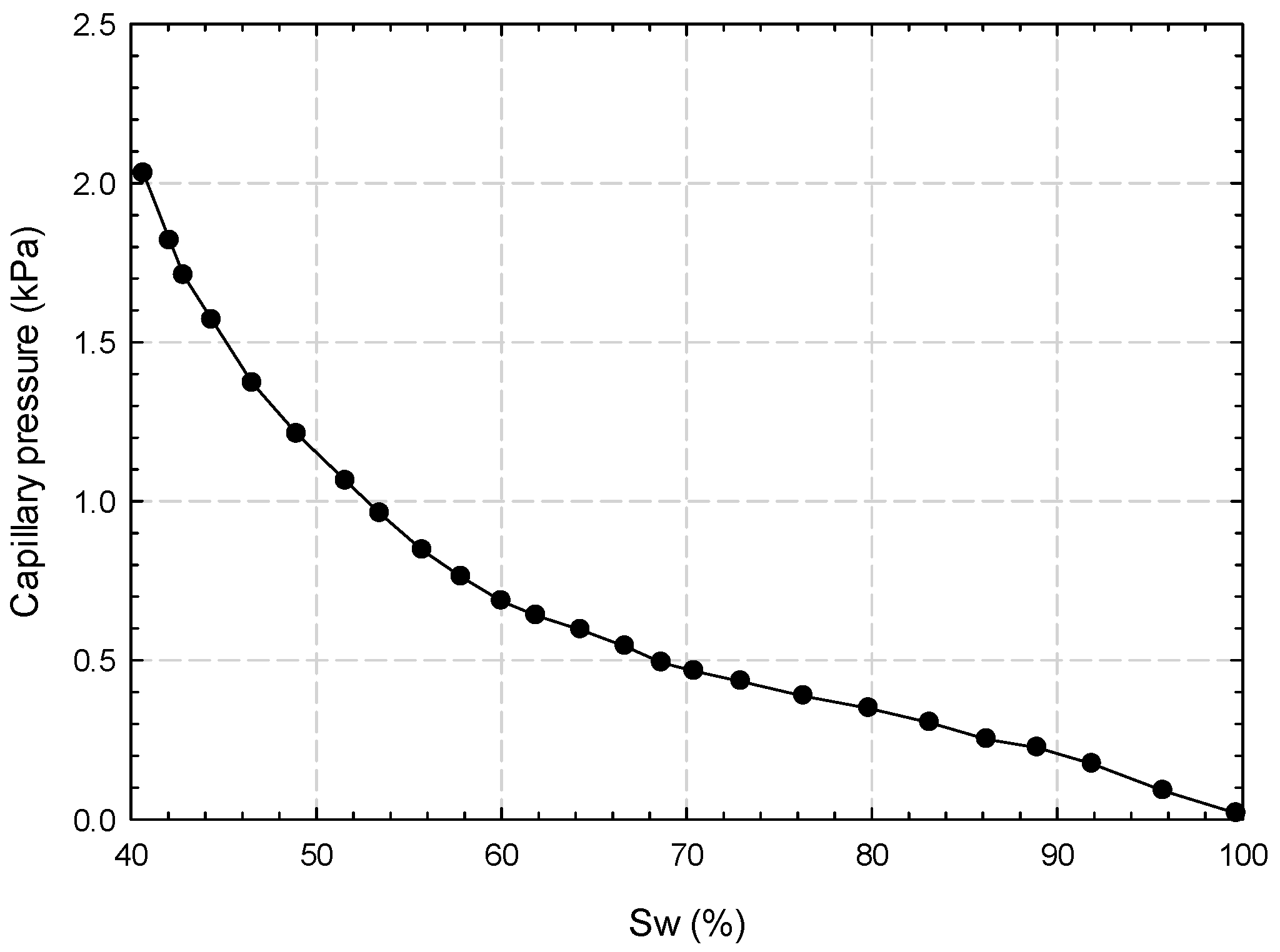

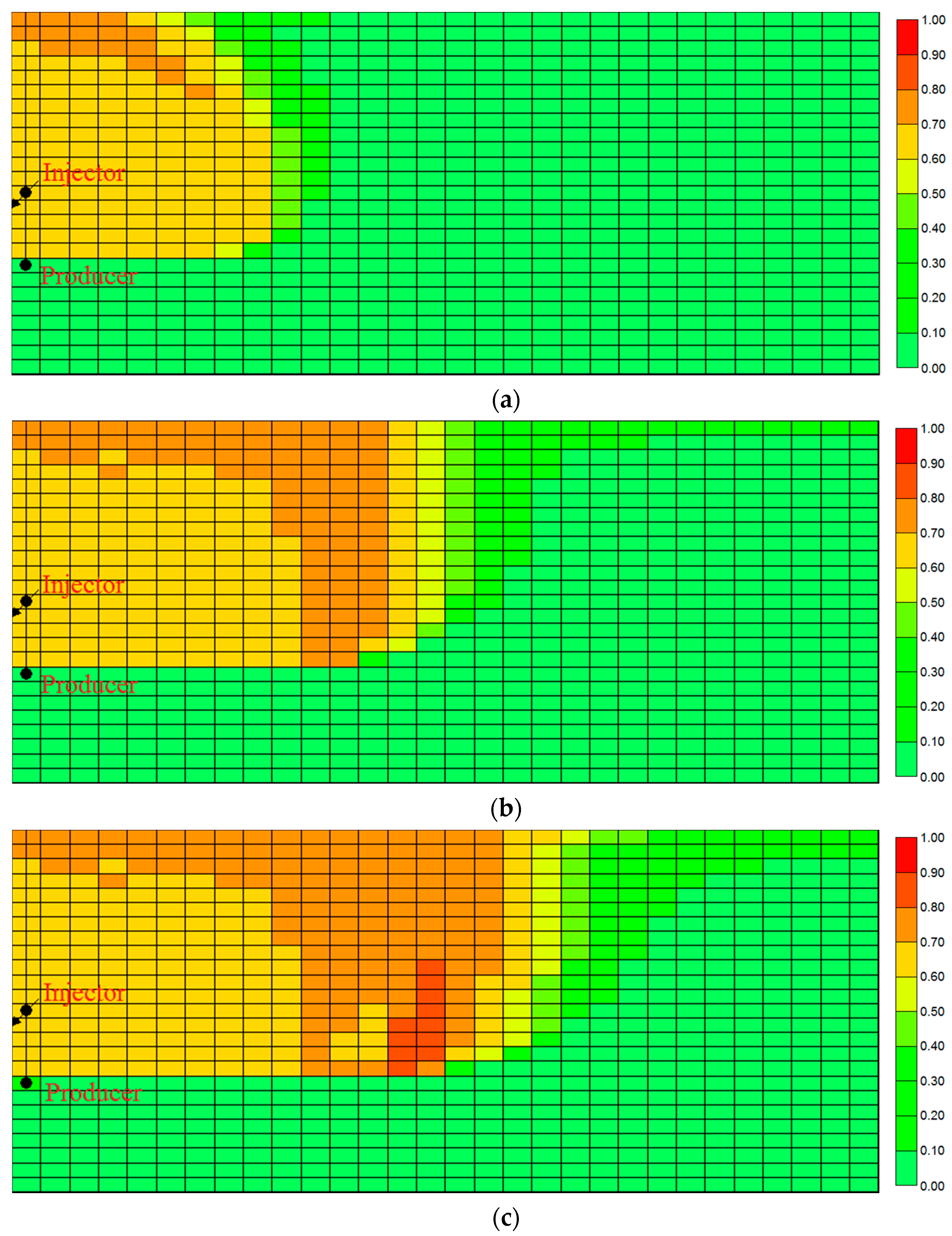
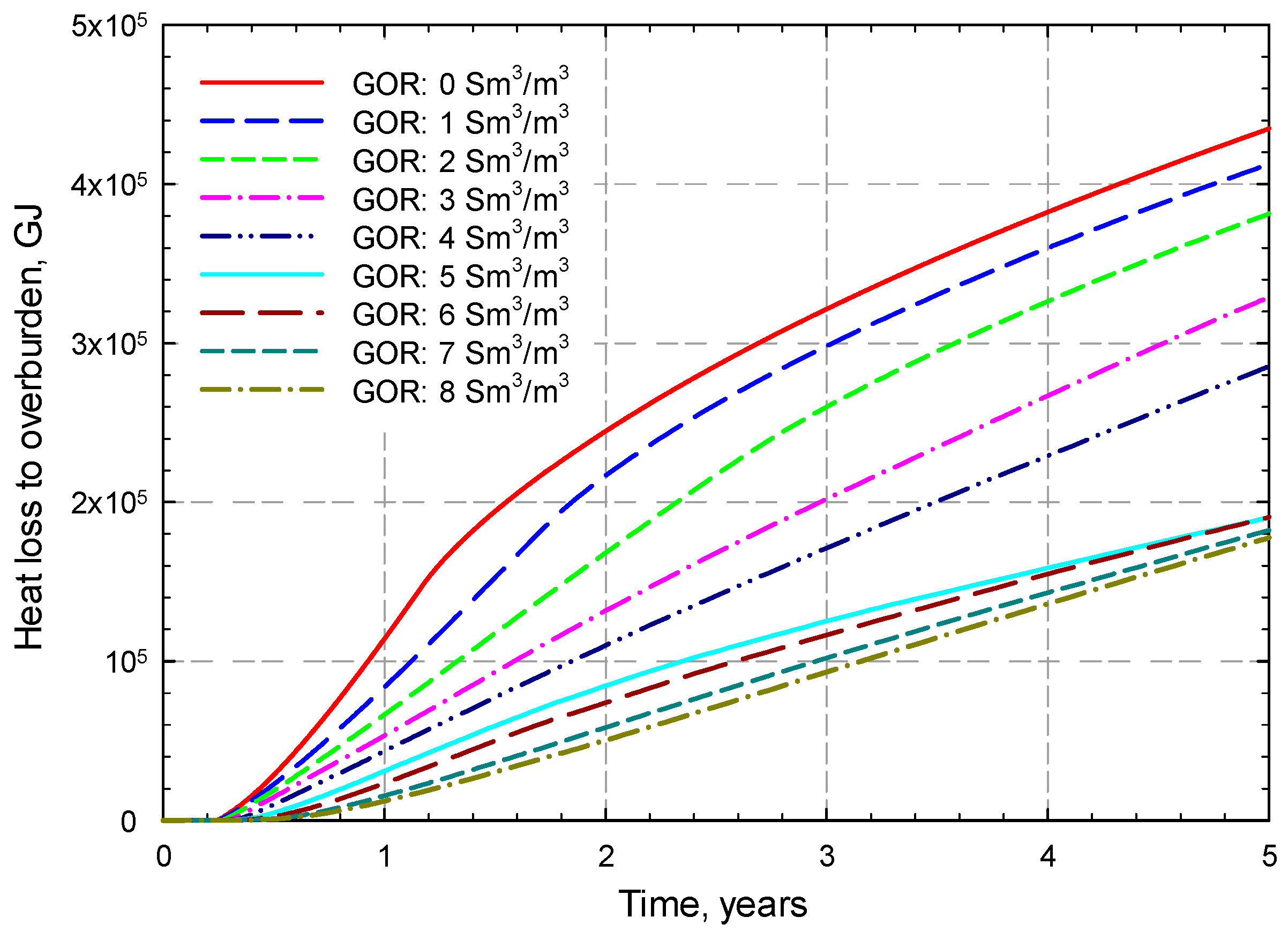
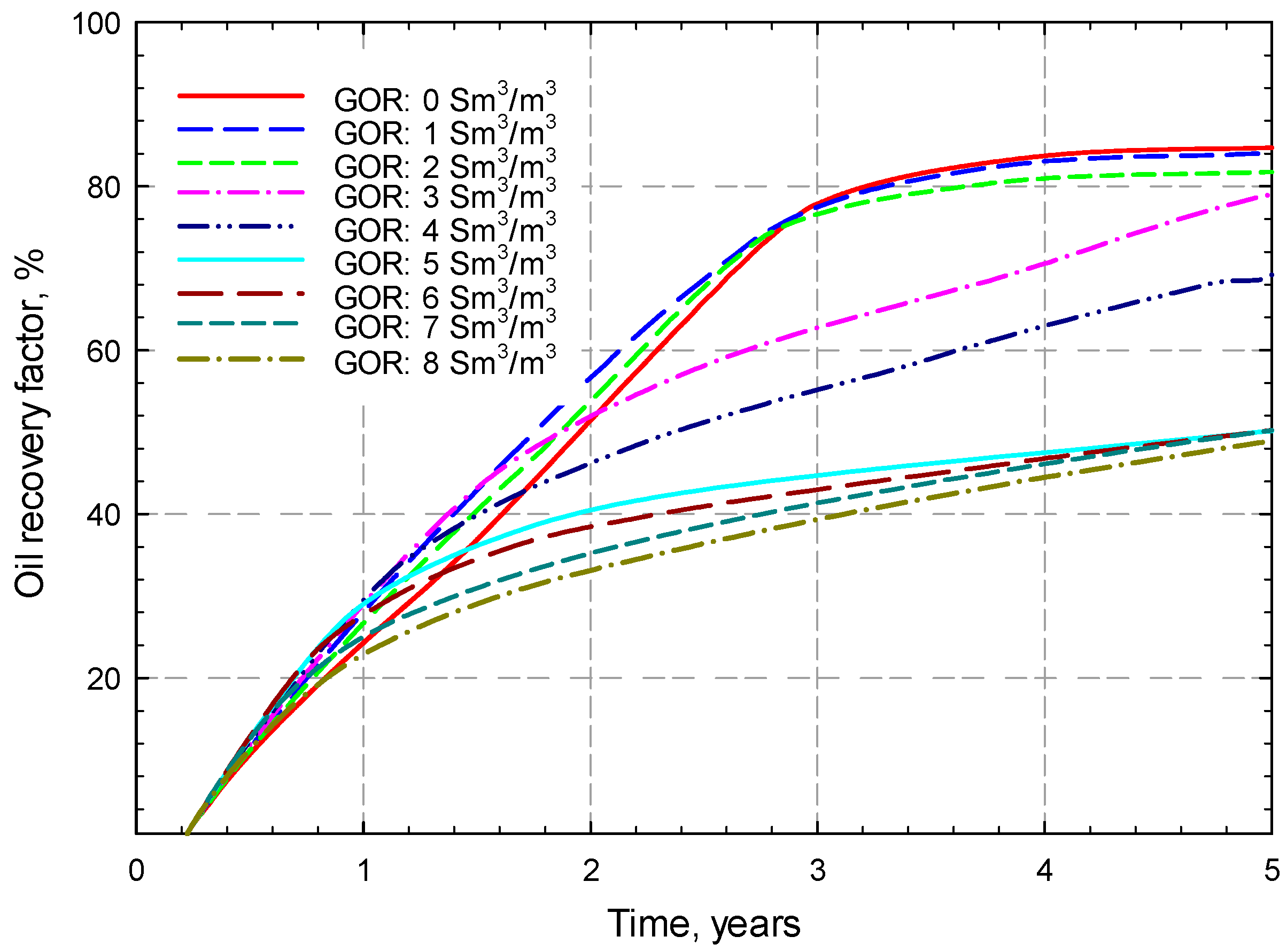
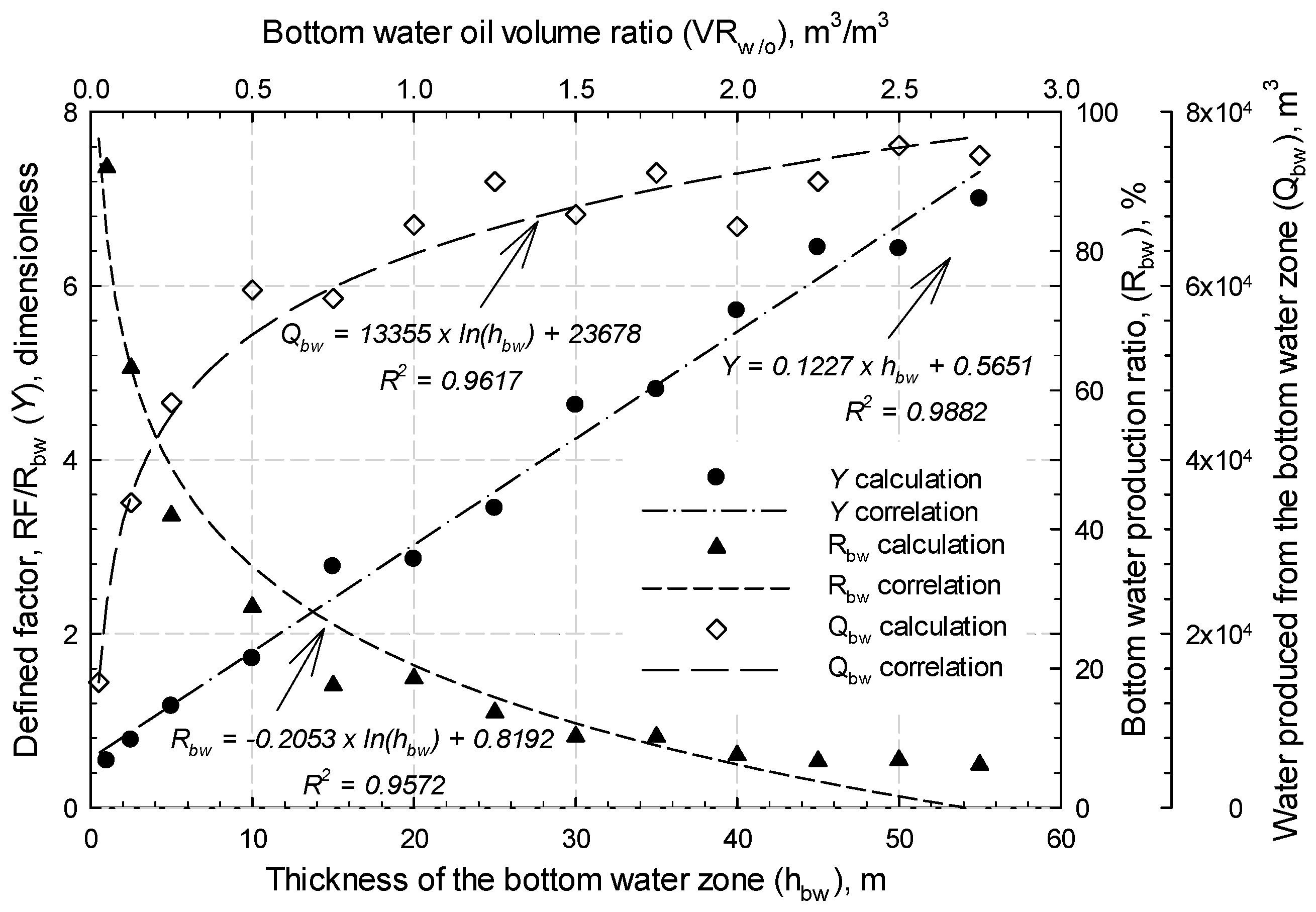



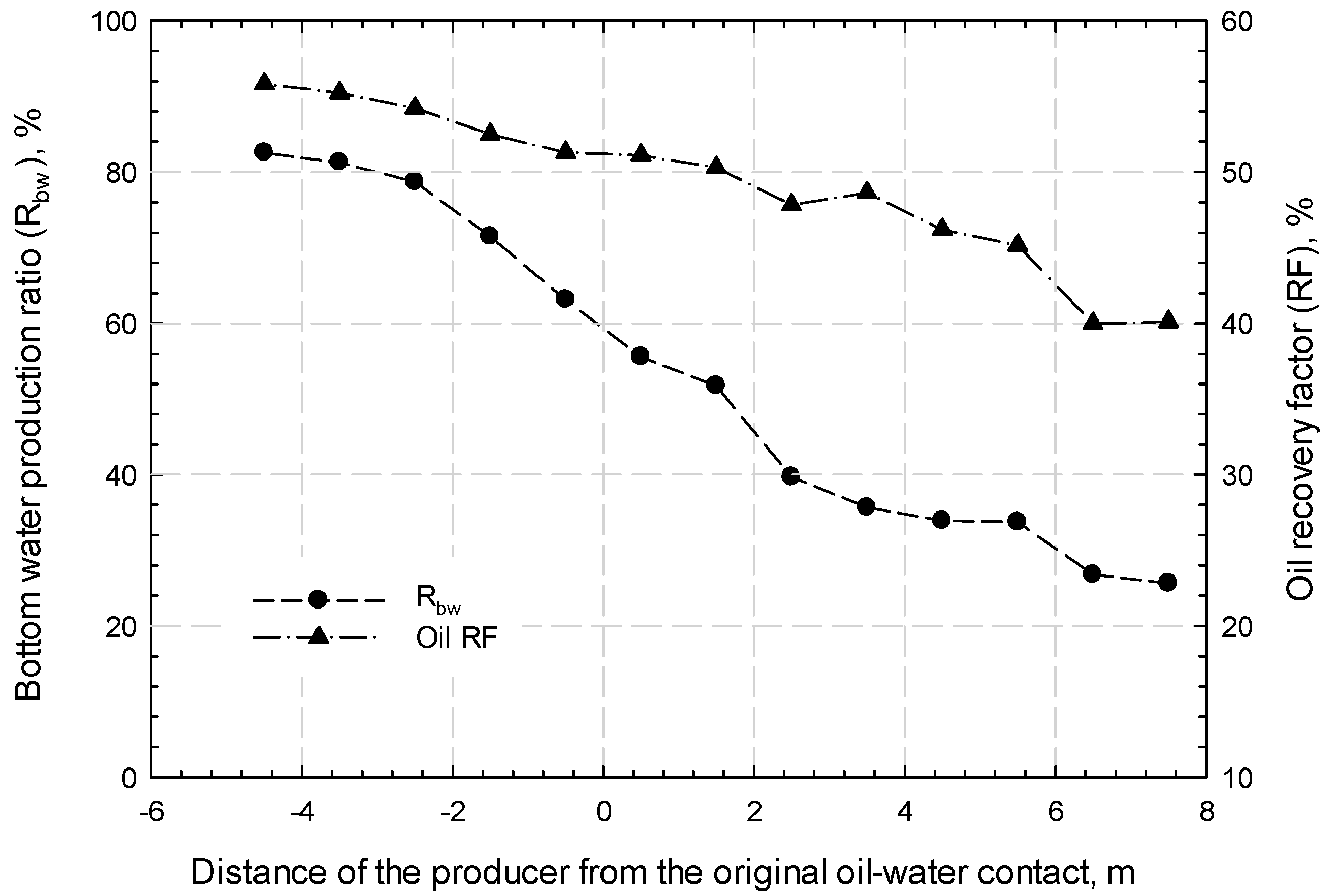
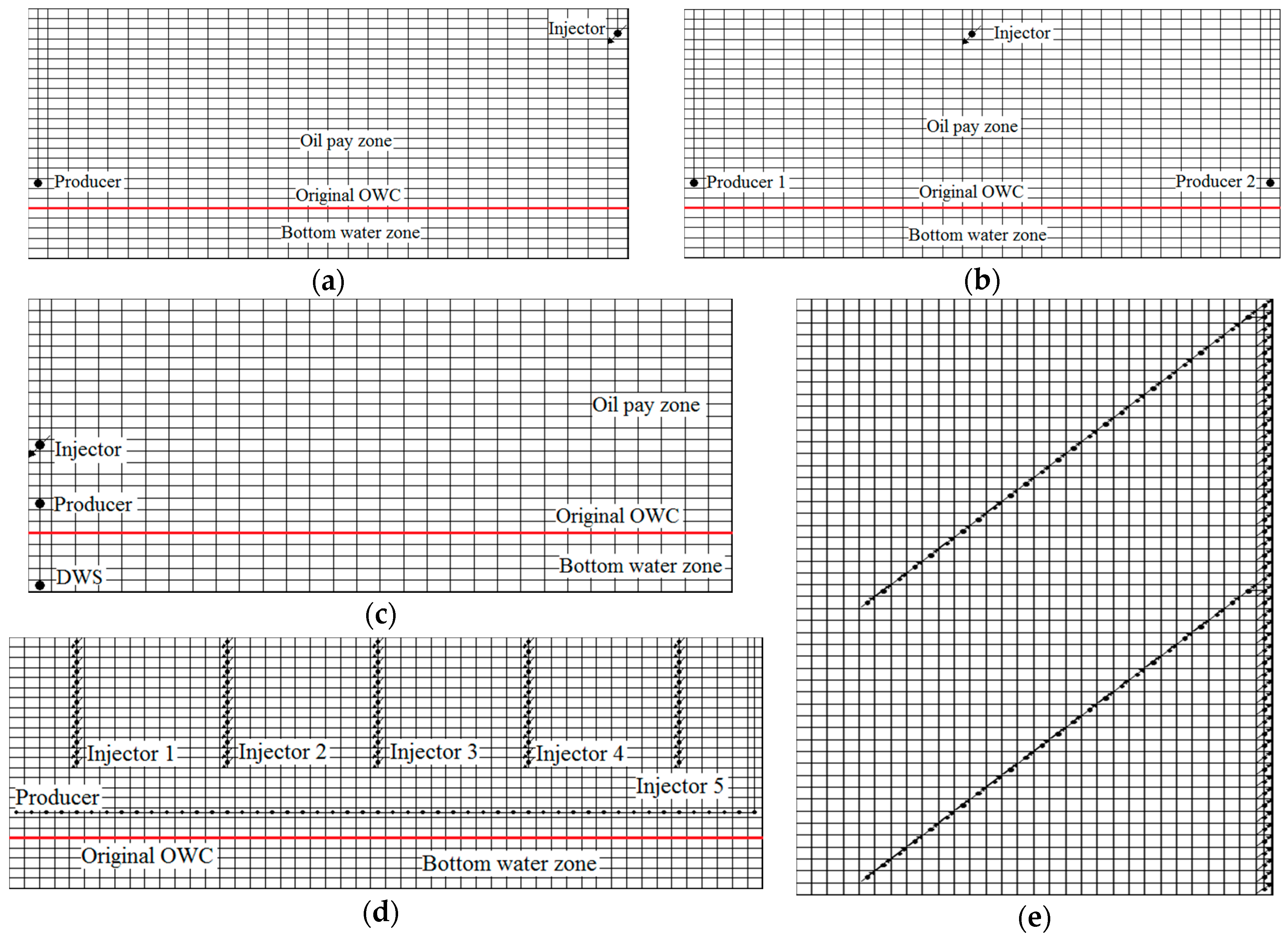

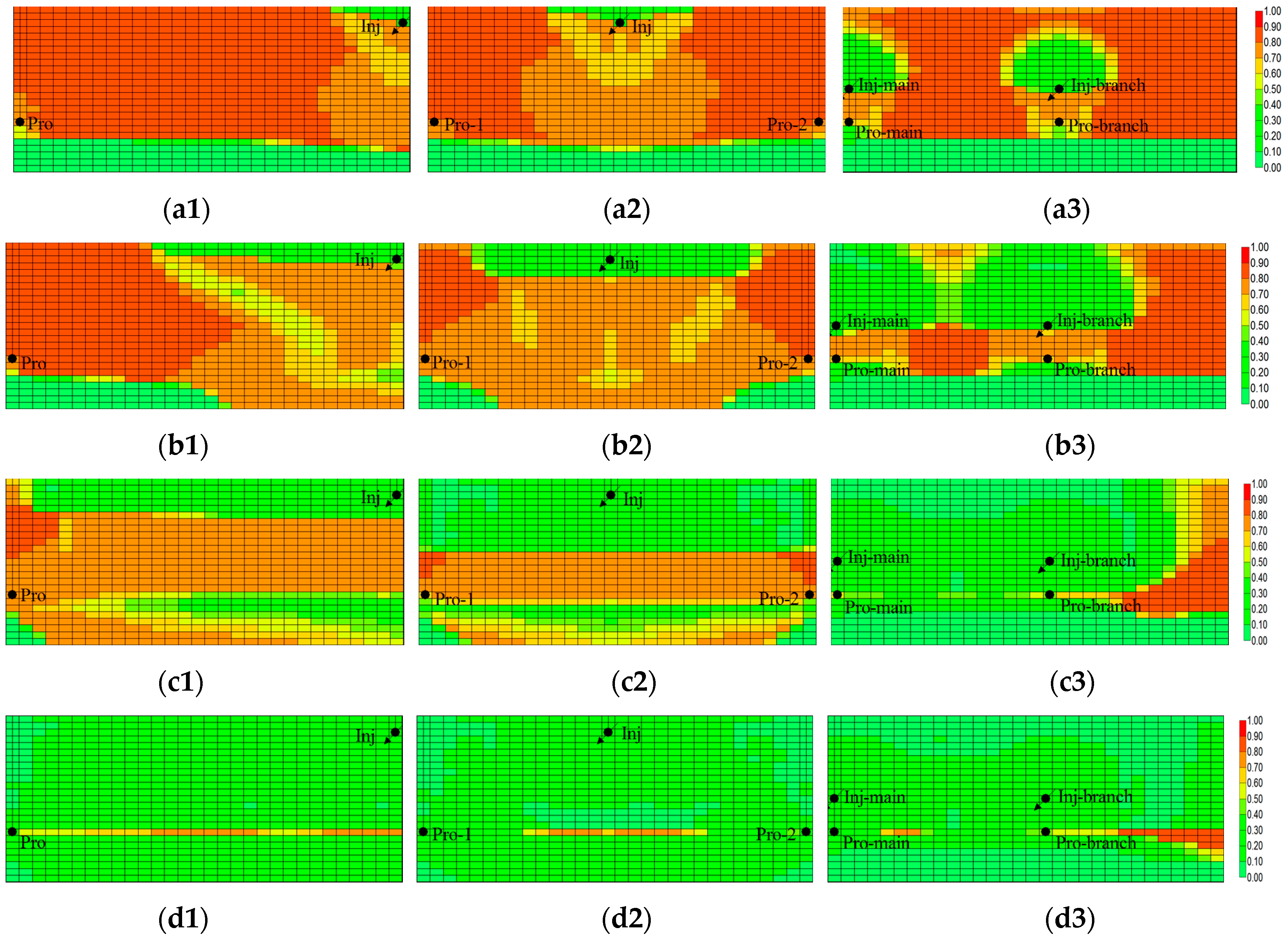
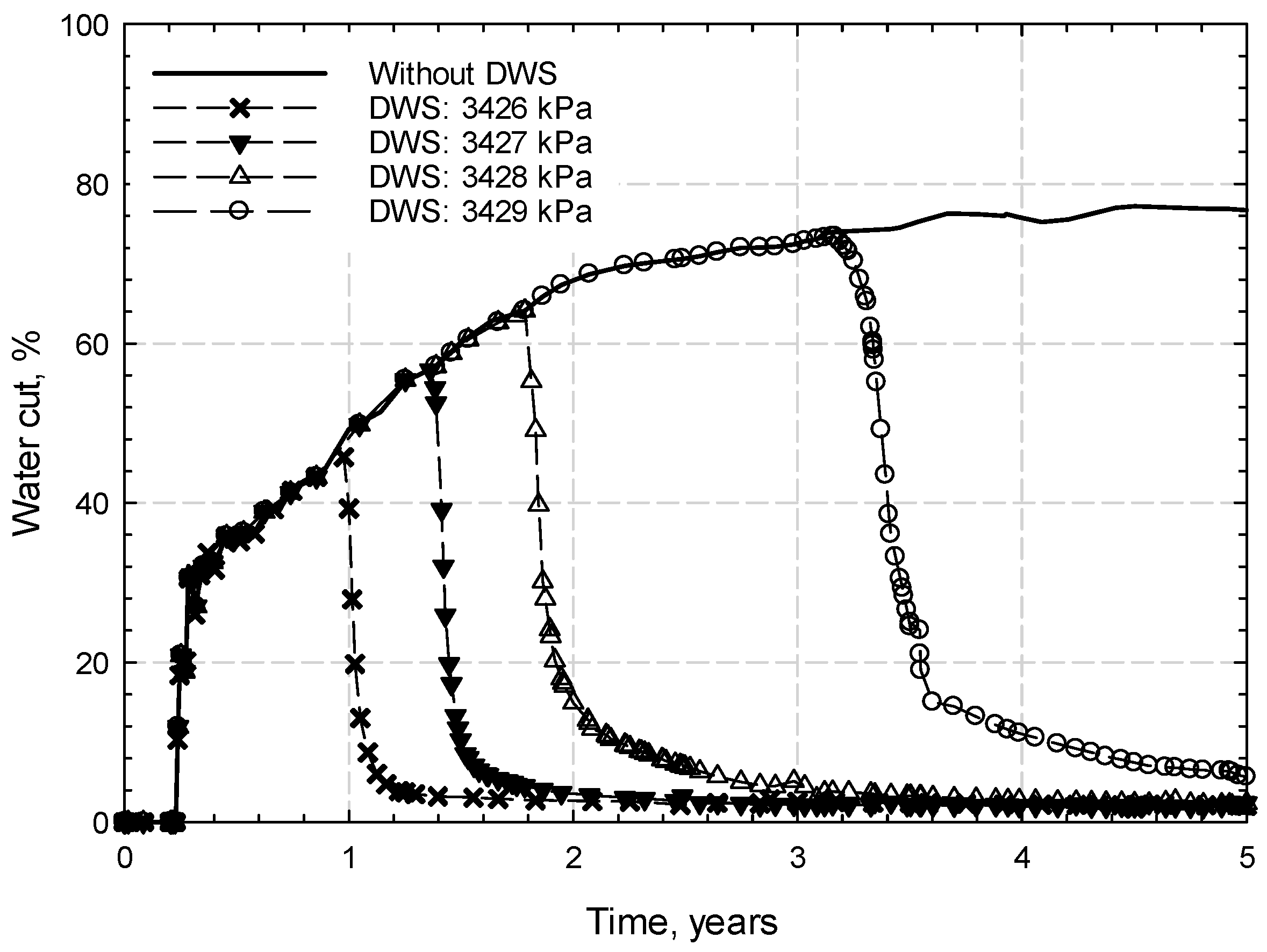
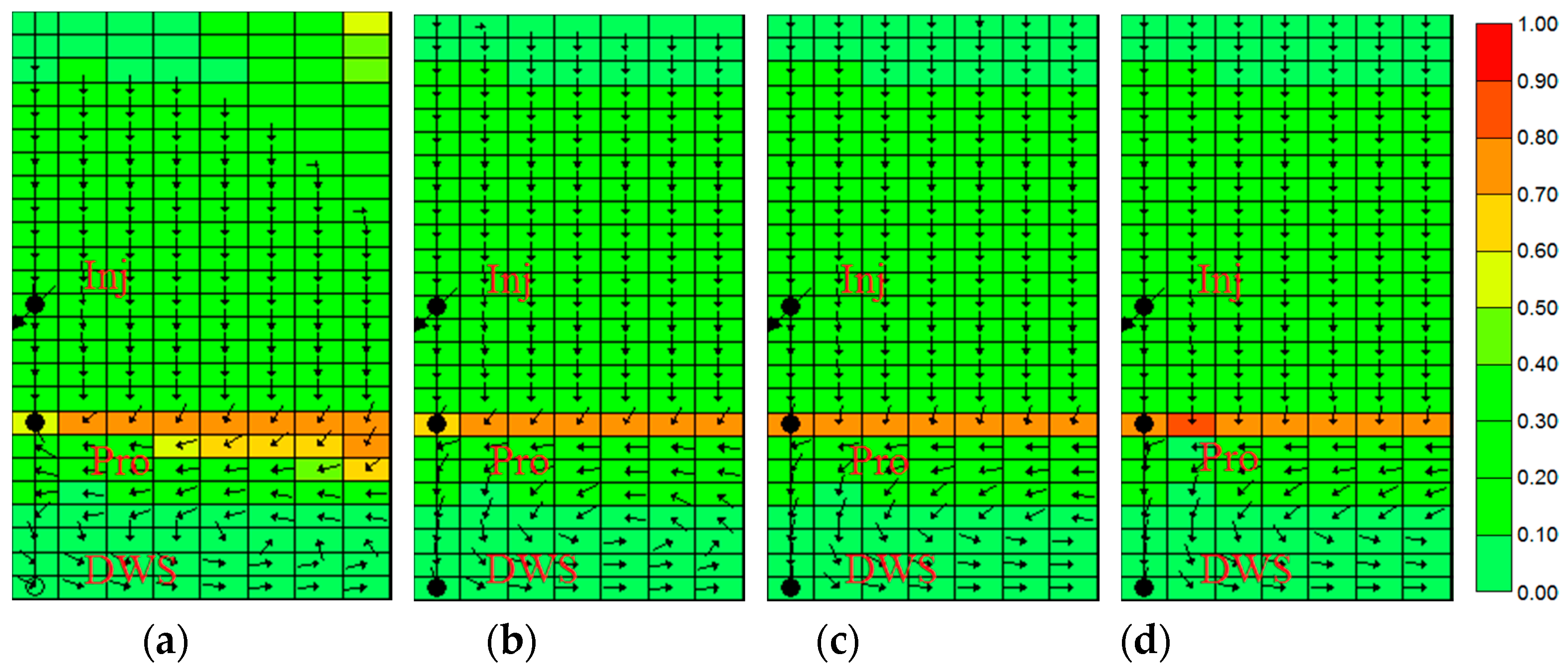
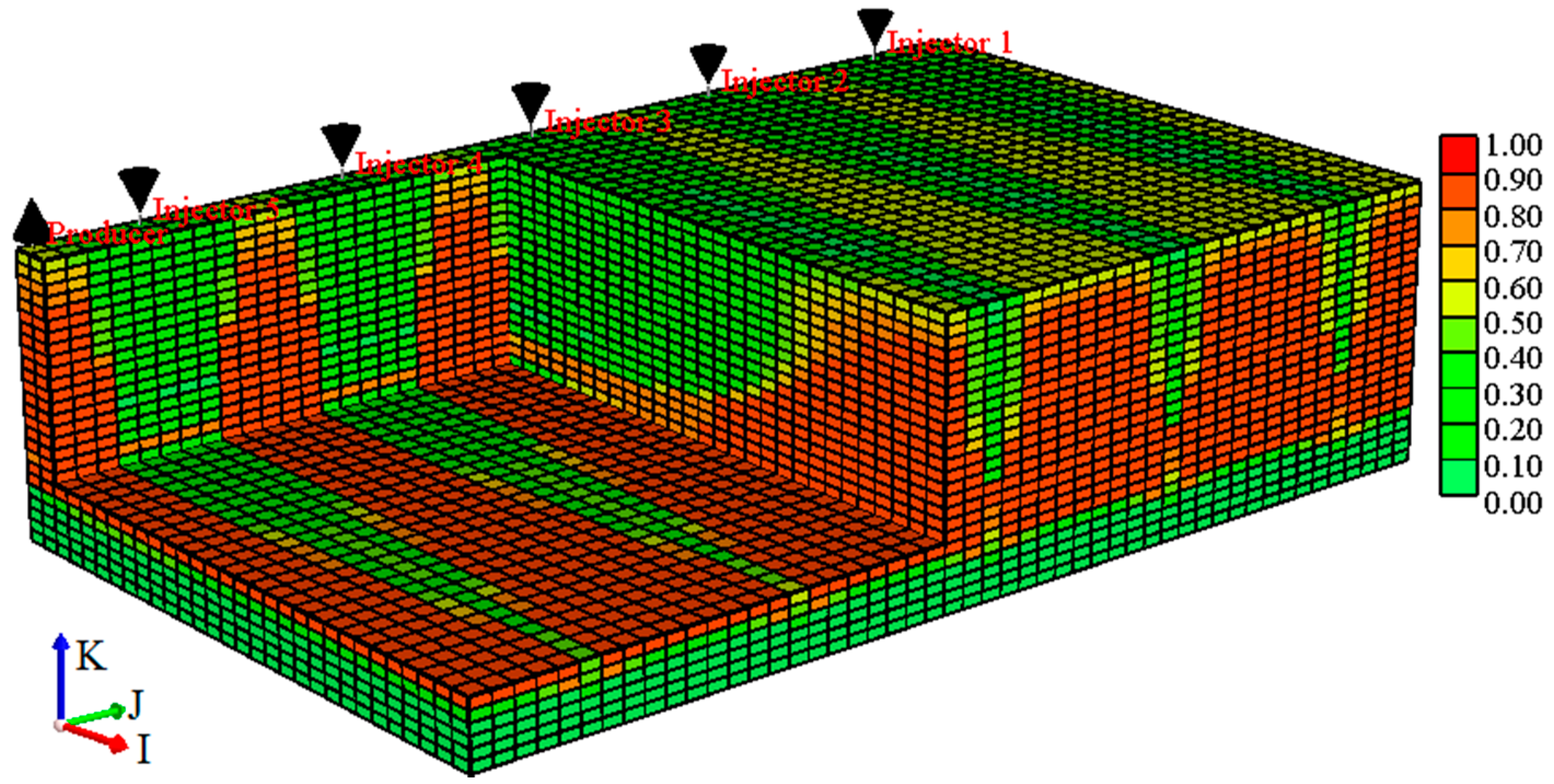
| Parameter | Value |
|---|---|
| Depth (m) a | 500 |
| Initial reservoir temperature (°C) a | 18 |
| Initial reservoir pressure (kPa) b | 3350 |
| Thickness of oil zone (m) a | 20 |
| Porosity a | 0.34 |
| Permeability in the oil zone (mD) a | 5000 |
| Permeability in the bottom water zone (mD) a | 2000 |
| Oil saturation a | 0.85 |
| Formation compressibility (1/kPa) c | 2.0 × 10−6 |
| Rock, over-/underburden heat capacity J/(m3·°C) d | 2.39 × 106 |
| Rock, over-/underburden thermal conductivity J/(m3·°C) d | 2.333 × 105 |
| Oil phase thermal conductivity J/(m3·°C) d | 2.0 × 104 |
| Water thermal conductivity J/(m3·°C) d | 5.35 × 104 |
| Method for evaluation of 3-phase Kro e | Stone’s second model |
| Methane K-value correlation e K = (KV1/P) × EXP((KV4)/(T−KV5)) | |
| KV1 (kPa) e | 5.4547 × 105 |
| KV4 (°C) e | −879.84 |
| KV5 (°C) e | −265.99 |
| Properties | Value |
|---|---|
| Density @18·°C (kg/m3) a | 985 |
| API gravity a | 12.4 |
| Viscosity @ 18·°C (mPa·s) a | 25,000 |
| Oil formation volume factor (m3/m3) a | 1.022 |
| Initial solution GOR (Sm3/m3) b | 8.0 |
| SARA composition (wt%) c | |
| Saturates | 23.1 |
| Aromatics | 41.7 |
| Resins | 19.5 |
| Asphaltenes | 15.3 |
| Solids | 0.4 |
| Water-Oil Relative Permeability | Liquid-Gas Relative Permeability | ||||
|---|---|---|---|---|---|
| Sw | Krw | Krow | Sl | Krg | Krog |
| 0.150 | 0.000 | 1.000 | 0.150 | 1.000 | 0.000 |
| 0.200 | 0.000 | 0.981 | 0.200 | 0.950 | 0.000 |
| 0.250 | 0.005 | 0.955 | 0.250 | 0.844 | 0.005 |
| 0.300 | 0.008 | 0.723 | 0.300 | 0.724 | 0.008 |
| 0.350 | 0.013 | 0.602 | 0.350 | 0.603 | 0.018 |
| 0.400 | 0.025 | 0.472 | 0.400 | 0.471 | 0.027 |
| 0.450 | 0.042 | 0.351 | 0.450 | 0.353 | 0.047 |
| 0.500 | 0.069 | 0.243 | 0.500 | 0.240 | 0.069 |
| 0.550 | 0.103 | 0.166 | 0.550 | 0.168 | 0.107 |
| 0.600 | 0.149 | 0.110 | 0.600 | 0.095 | 0.156 |
| 0.650 | 0.207 | 0.072 | 0.650 | 0.079 | 0.209 |
| 0.700 | 0.275 | 0.040 | 0.700 | 0.047 | 0.274 |
| 0.750 | 0.354 | 0.016 | 0.750 | 0.033 | 0.354 |
| 0.800 | 0.449 | 0.000 | 0.800 | 0.024 | 0.450 |
| 0.850 | 0.565 | 0.000 | 0.850 | 0.014 | 0.564 |
| 0.900 | 0.693 | 0.000 | 0.900 | 0.009 | 0.689 |
| 0.950 | 0.838 | 0.000 | 0.950 | 0.005 | 0.838 |
| 1.000 | 1.000 | 0.000 | 1.000 | 0.000 | 1.000 |
| So,bw | OOIP | Rinc,OOIP | Rbw | Rinc,Rbw | RF | Rinc,RF | cEOR | Rinc,cEOR |
|---|---|---|---|---|---|---|---|---|
| % | 105 m3 | % | % | % | % | % | GJ/m3 | % |
| 0 | 3.775 | - | 41.953 | - | 48.972 | - | 4.062 | - |
| 10 | 3.886 | 2.943 | 46.462 | 10.748 | 49.250 | 0.568 | 3.994 | −1.671 |
| 20 | 3.997 | 5.884 | 45.557 | 8.591 | 49.024 | 0.107 | 3.912 | −3.682 |
| 30 | 4.108 | 8.827 | 45.242 | 7.838 | 49.581 | 1.245 | 3.752 | −7.627 |
| 40 | 4.219 | 11.768 | 43.274 | 3.149 | 45.886 | −6.301 | 3.624 | −10.782 |
| 50 | 4.330 | 14.711 | 37.311 | −11.066 | 43.282 | −11.619 | 3.325 | −18.128 |
© 2017 by the authors. Licensee MDPI, Basel, Switzerland. This article is an open access article distributed under the terms and conditions of the Creative Commons Attribution (CC BY) license (http://creativecommons.org/licenses/by/4.0/).
Share and Cite
Ni, J.; Zhou, X.; Yuan, Q.; Lu, X.; Zeng, F.; Wu, K. Numerical Simulation Study on Steam-Assisted Gravity Drainage Performance in a Heavy Oil Reservoir with a Bottom Water Zone. Energies 2017, 10, 1999. https://doi.org/10.3390/en10121999
Ni J, Zhou X, Yuan Q, Lu X, Zeng F, Wu K. Numerical Simulation Study on Steam-Assisted Gravity Drainage Performance in a Heavy Oil Reservoir with a Bottom Water Zone. Energies. 2017; 10(12):1999. https://doi.org/10.3390/en10121999
Chicago/Turabian StyleNi, Jun, Xiang Zhou, Qingwang Yuan, Xinqian Lu, Fanhua Zeng, and Keliu Wu. 2017. "Numerical Simulation Study on Steam-Assisted Gravity Drainage Performance in a Heavy Oil Reservoir with a Bottom Water Zone" Energies 10, no. 12: 1999. https://doi.org/10.3390/en10121999





